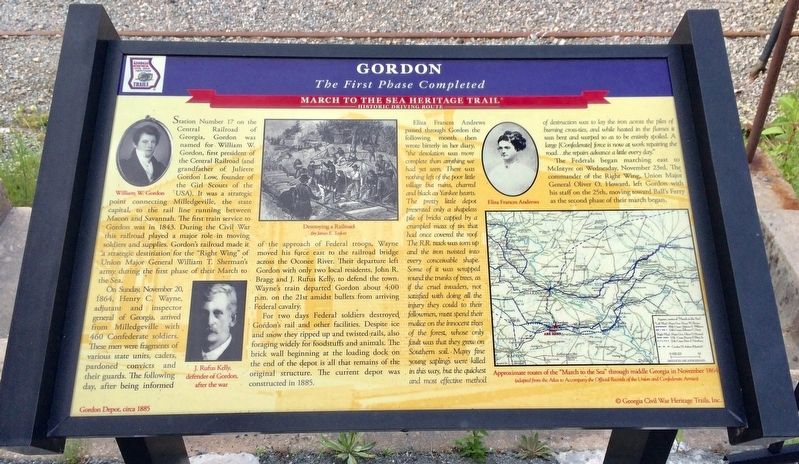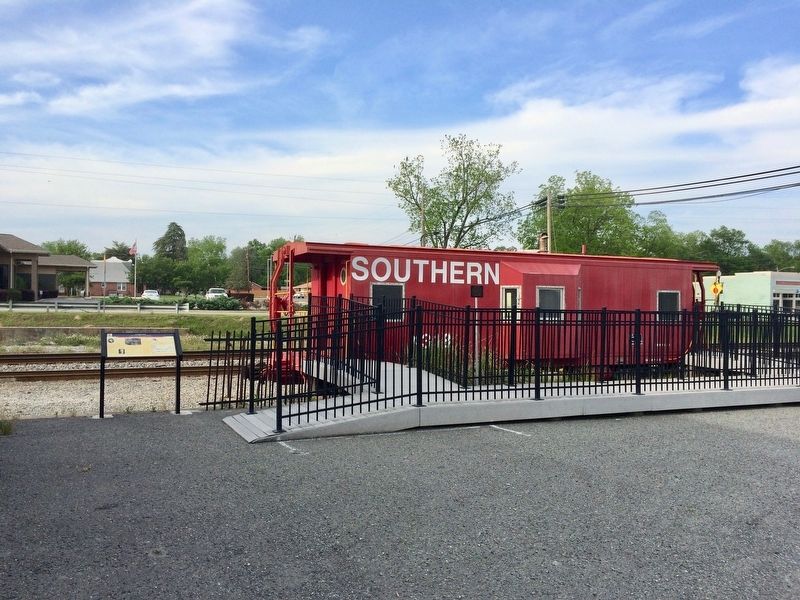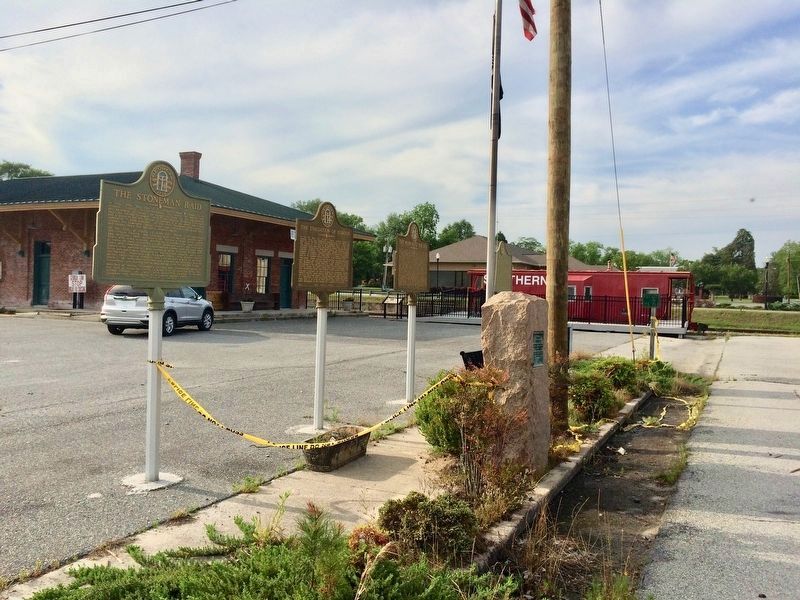Gordon in Wilkinson County, Georgia — The American South (South Atlantic)
Gordon
The First Phase Completed
— March to the Sea Heritage Trail —
On Sunday, November 20, 1864, Henry C. Wayne, adjutant and inspector general of Georgia, arrived from Milledgeville with 460 Confederate soldiers. These men were fragments of various state units, cadets pardoned convicts and their guards. The following day, after being informed of the approach of Federal troops, Wayne moved his force east to the railroad bridge across the Oconee River. Their departure left Gordon with only two local residents, John R. Bragg and J. Rufus Kelly, to defend the town. Wayne's train departed Gordon about 4:00 p.m. on the 21st amidst bullets from arriving Federal cavalry.
For two days Federal soldiers destroyed Gordon's rail and other facilities. Despite ice and snow they ripped up and twisted rails, also foraging widely for foodstuffs and animals. The brick wall beginning at the loading dock on the end of the depot is all that remains of the original structure. The current depot was constructed in 1885.
Eliza Frances Andrews passed through Gordon the following month then wrote bitterly in her diary, "the desolation was more complete than anything we had yet seen. There was nothing left of the poor little village but ruins, charred and black as Yankee hearts. The pretty little depot presented only a shapeless pile of bricks capped by a crumbled mass of tin that had once covered the roof. The R. R. track was torn up and the iron twisted into every conceivable shape. Some of it was wrapped round the trunks of trees, as if the cruel invaders, not satisfied with doing all the injury they could to their fellowmen, must spend their malice on the innocent trees of the forest, whose only fault was that they grew on Southern soil, Many fine young saplings were killed in this way, but the quickest and most effective method of destruction was to lay the iron across the piles of burning cross-ties, and while heated in the flames it was bent and warped so as to be entirely spoiled. A large [Confederate] force is now at work repairing the the repairs advance a little every day.
The Federals began marching east to
McIntyre on Wednesday, November 23rd. The commander of the Right Wing, Union Major General Oliver O. Howard, left Gordon with his staff on the 25th, moving toward Ball's Ferry as the second phase of their march began.
[Photo captions]
Top left: William W. Gordon
Bottom left: J. Rufus Kelly, defender of Gordon, after the war
Middle: Destroying a Railroad
(by James E. Taylor)
Top right: Eliza Frances Andrews
Bottom right map: Approximate routes of the "March to the Sea" through middle Georgia in November 1864
(adopted from the Atlas to Accompany the Official Records of the Union and Confederate Armies)
Background watermark: Gordon Depot, circa 1885
Erected by Georgia Civil War Heritage Trails, Inc. (Marker Number R12.)
Topics and series. This historical marker is listed in these topic lists: Railroads & Streetcars • War, US Civil. In addition, it is included in the Georgia Civil War Trails, and the Sherman’s March to the Sea series lists. A significant historical date for this entry is November 20, 1864.
Location. 32° 52.92′ N, 83° 20.051′ W. Marker is in Gordon, Georgia, in Wilkinson County. Marker is at the intersection of Jackson Street and Macon Road, on the right when traveling west on Jackson
Street. Touch for map. Marker is at or near this postal address: 90 Jackson Street, Gordon GA 31031, United States of America. Touch for directions.
Other nearby markers. At least 8 other markers are within 6 miles of this marker, measured as the crow flies. He Wouldn't Run (within shouting distance of this marker); The March to the Sea (within shouting distance of this marker); Gordon Depot-Museum (within shouting distance of this marker); The Evacuation of Gordon (within shouting distance of this marker); In Memory of J. Rufus Kelly (within shouting distance of this marker); The Stoneman Raid (within shouting distance of this marker); Ramah Church (approx. 1.6 miles away); Battle of Griswoldville (approx. 5.2 miles away). Touch for a list and map of all markers in Gordon.
Also see . . . Wikipedia article on William W. Gordon. (Submitted on May 4, 2017, by Mark Hilton of Montgomery, Alabama.)
Credits. This page was last revised on May 6, 2017. It was originally submitted on May 4, 2017, by Mark Hilton of Montgomery, Alabama. This page has been viewed 911 times since then and 61 times this year. Photos: 1, 2, 3. submitted on May 4, 2017, by Mark Hilton of Montgomery, Alabama.


